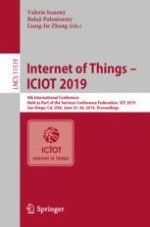This book constitutes the proceedings of the International Conference on Internet of Things, ICIOT 2019, held as part of SCF 2019, in San Diego, CA, USA, in June 2019.
The 8 full and 3 short papers presented in this volume were carefully reviewed and selected from 16 submissions. With the rapid advancements of mobile Internet, cloud computing and big data, device-centric traditional Internet of Things (IoT) is now moving into a new era which is termed as Internet of Things Services (IOTS). In this era, sensors and other types of sensing devices, wired and wireless networks, platforms and tools, data processing/visualization/analysis and integration engines, and other components of traditional IoT are interconnected through innovative services to realize the value of connected things, people, and virtual Internet spaces.
